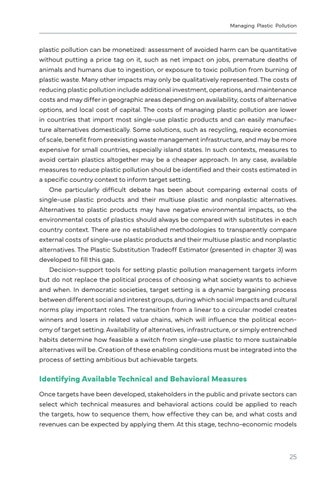Managing Plastic Pollution
plastic pollution can be monetized: assessment of avoided harm can be quantitative without putting a price tag on it, such as net impact on jobs, premature deaths of animals and humans due to ingestion, or exposure to toxic pollution from burning of plastic waste. Many other impacts may only be qualitatively represented. The costs of reducing plastic pollution include additional investment, operations, and maintenance costs and may differ in geographic areas depending on availability, costs of alternative options, and local cost of capital. The costs of managing plastic pollution are lower in countries that import most single-use plastic products and can easily manufacture alternatives domestically. Some solutions, such as recycling, require economies of scale, benefit from preexisting waste management infrastructure, and may be more expensive for small countries, especially island states. In such contexts, measures to avoid certain plastics altogether may be a cheaper approach. In any case, available measures to reduce plastic pollution should be identified and their costs estimated in a specific country context to inform target setting. One particularly difficult debate has been about comparing external costs of single-use plastic products and their multiuse plastic and nonplastic alternatives. Alternatives to plastic products may have negative environmental impacts, so the environmental costs of plastics should always be compared with substitutes in each country context. There are no established methodologies to transparently compare external costs of single-use plastic products and their multiuse plastic and nonplastic alternatives. The Plastic Substitution Tradeoff Estimator (presented in chapter 3) was developed to fill this gap. Decision-support tools for setting plastic pollution management targets inform but do not replace the political process of choosing what society wants to achieve and when. In democratic societies, target setting is a dynamic bargaining process between different social and interest groups, during which social impacts and cultural norms play important roles. The transition from a linear to a circular model creates winners and losers in related value chains, which will influence the political economy of target setting. Availability of alternatives, infrastructure, or simply entrenched habits determine how feasible a switch from single-use plastic to more sustainable alternatives will be. Creation of these enabling conditions must be integrated into the process of setting ambitious but achievable targets.
Identifying Available Technical and Behavioral Measures Once targets have been developed, stakeholders in the public and private sectors can select which technical measures and behavioral actions could be applied to reach the targets, how to sequence them, how effective they can be, and what costs and revenues can be expected by applying them. At this stage, techno-economic models
25





